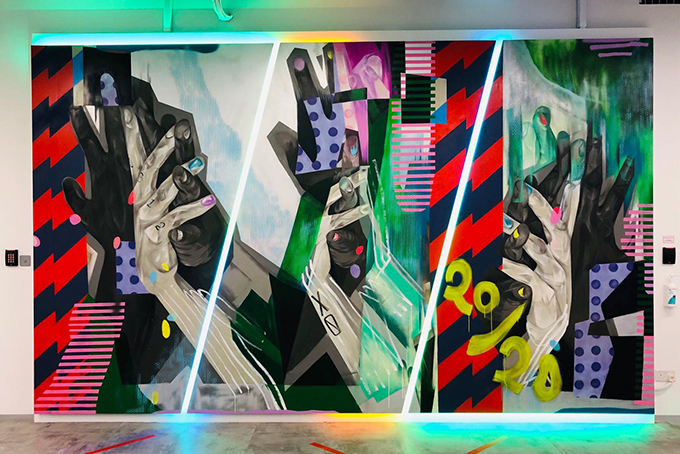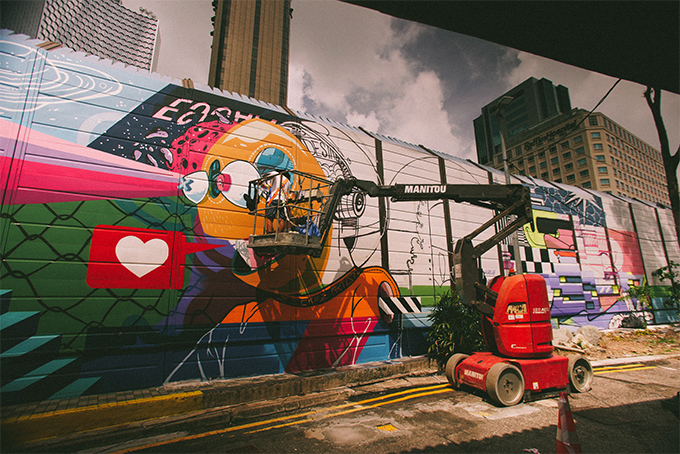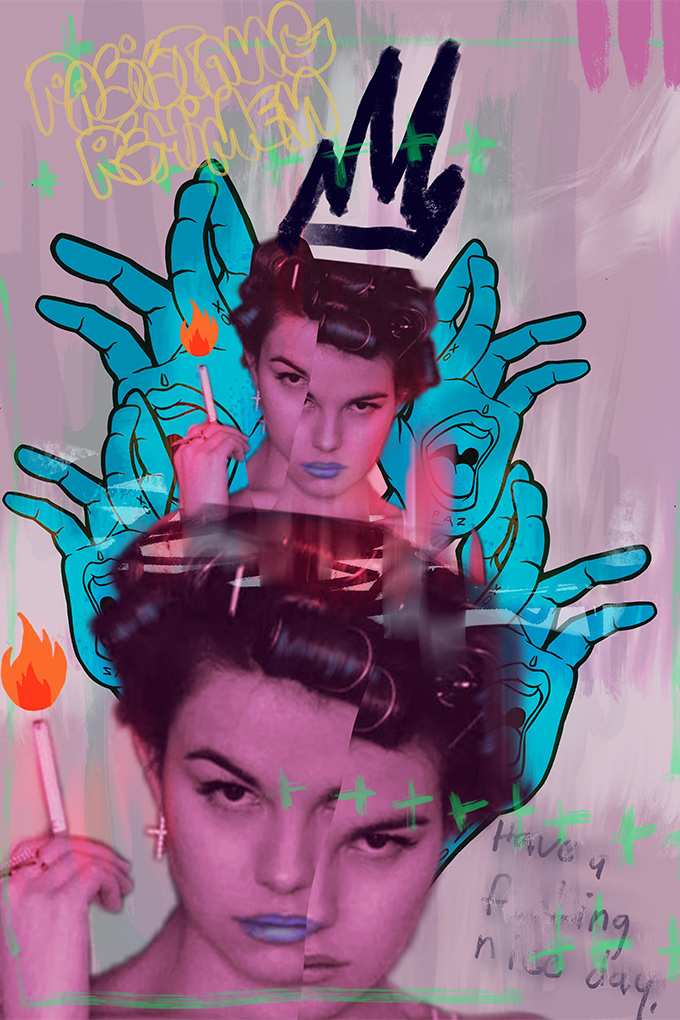The North-South Corridor will eventually connect one end of Singapore directly to another. For now, though, it’s just an eyesore. Not its construction; rather, it’s the neat, bureaucratic noise barriers that stand five metres high. These walls were plain and undecorated—that is, until this past April, when One Kampong Gelam announced the opening of Southeast Asia’s first official graffiti Hall of Fame, splashed across more than 230 metres of barrier.
Intending to add a sense of vibrancy and freedom of expression to the stretch of roadside, the project needed an array of artists diverse, visionary, and handy with a spray can. One of those artists is SPAZ, or Laurie Maravilla. She and 16 other prolific artists (like ANTZ, Hegira, Studio Moonchild, and Dem) were called to the cause, and have spent months tricking the barriers out with both standalone and collaborative murals.

SPAZ’s mural is called The Kampong Gelam Way. It sits on Ophir Road (the Hall of Fame runs all the way to Bali Lane), and adds a pop of colour to a quarter laden with local history and culture. Kampong Gelam was already known as a hub for the arts, much of it having been covered in (legal, often commissioned) graffiti over the years. The Hall of Fame just bolsters its position as the country’s largest open-air gallery.
Maravilla feels a special connection to the neighborhood; it’s where her studio is based, and she knows every inch of it. As she puts it, she and her community have painted these walls “over and over and over and over again.” Originally from Manila, she’s a two-time recipient of the LASALLE Scholarship and the first Southeast Asian to win the Takifuji International Art Award in 2013.
But she’s more focused on, and invested in, spreading awareness and opportunity for other young female artists across the region. SPAZ has co-founded both The Solidarity Movement, a project seeking to establish and document urban art as it explodes across Asia, and Rebel Daughters, a community for female, trans, and gender non-conforming artists. Recently, she took time out of her busy schedule to chat with Vogue Singapore about self-determination, her artistic roots, and what she wants to do next.

How did you get into urban art?
I never set out to do street art or graffiti. I did fashion in college, and then threw myself into so many different, creative things afterwards. At one point, I owned this business in the Philippines, selling old records. The tenants downstairs were a bunch of graffiti artists who sold t-shirts. We were hanging out one day after work and I told them, “Oh, I love painting large-scale stuff.” I meant, like, as big as my arm. They misunderstood, and said, “You do? You should come and paint with us.”
They brought me out to paint illegally one night. I had no idea we were doing it illegally. I didn’t know anything about street art back then. It was basically like an alley, super dirty. Quite the experience. But I never forgot about it, and never really did any other kind of art beyond that. I liked the idea of going beyond what society thinks I should be up to as a woman. Taking up space, painting on walls, larger than life.
What did you paint, that first night?
Oh my gosh. [Laughs] It was so ambitious. Before that night, I was just painting with normal brushes and acrylics. I wanted to paint, like, a ton of faces, but I’d never handled spray paint before. It was a nightmare. I think I ended up painting one face, all over the place. It looked kinda like tokidoki, you know, that visual style. My second piece was a big chicken, made with a roller. But yeah—my first piece was nuts.
How did you develop your style?
It took me quite a while. It was, for a long time, more about getting out there and just putting my name everywhere, or placing my stickers. After my first experience, I realised I wasn’t ready for the huge stuff. So these were small, handmade stickers I made with markers and sticker paper. I just put them everywhere.
That’s the experience I like: going out and being aware of my surroundings, and interacting with it. Back then, when I drew, it wasn’t something I was able to translate to a huge wall. I didn’t have the skills. What was happening in the Philippines was just destruction. But I kept at it, and started doing graffiti portraits. I started painting angry women, and grew from there. There was a lot of experimentation.

So how did that change when you moved to Singapore? Obviously we have some pretty strict laws regarding vandalism.
I got here and figured out pretty quick that they cane people who vandalise. So I stopped for a few years. Then I ended up going to art school here—LASALLE—and meeting some people that I would eventually work with. That included my now-husband, Zero [Zulkarnaen Othman]. They just started inviting me to meet with them. I was pleasantly surprised to find out that graffiti and street art don’t exist the same way it does in the Philippines, but it does exist. So I ran with it.
Zero helped to spearhead RSCLS [pronounced ras-kuhls]. Can you tell us more about that?
RSCLS is an urban arts collective. A lot of us have known each other for, like, 20 years. I came in quite late, after 2010. But many of them had been practicing graffiti way before it was—well, it’s still not legal, but acceptable. A lot of them are skateboarders, BMX riders. Graffiti was one more thing that everybody did together.
Eventually, we kind of realised that, okay, we can be doing more for our community. So we started creating safe spaces for people to develop their craft or even just come in and learn more about it. Around 2012, I wanted to give back to the artists who helped me get started, over in the Philippines, so we started doing all of these artist exchange programs. We organised, we developed new talents, took kids under our wing. It was a really fun time.
What else should we know about the urban artist community?
It’s getting old, man. [Laughs] A lot of us have been doing this for quite a while. It’s very tight-knit. We’ve realised that we need to support each other, especially during the pandemic. Not everybody’s getting jobs. So we try and push opportunities to expand to involve more people.
We’re focused on making sure everybody survives this, and on developing new talent. Because, like I said, a lot of us are getting older. We’re working on getting new blood. Especially women.
How much of that new blood is female, right now?
The youngest female artist I know here is Anacathie, who’s half of Studio Moonchild. But getting female artists involved, in general, that’s always been a source of frustration for me. It seems like since my friend Sam [also known as skl0_] established Rebel Daughters, there are even fewer women doing this now. I don’t really know why. Life happens. So we were trying to tackle, even in the beginning, that issue of why women eventually stop practicing. Not even limited to graffiti—the arts in general, right?

That’s got to be pretty tough on the rest of the women in the community.
Yep. But I won’t shut up about it. The guys started catching on, learning how they should be supporting women in the community. At the start, it was hard—they were not used to women being vocal. So we in Rebel Daughters just started calling them out, and claiming space. It was a nightmare at first. But you just had to be relentless. We learned how to be with each other, existing and accepting and helping one another. It’s not as bad anymore, but we’re still vastly outnumbered.
Can you tell us more about Rebel Daughters?
As artists, we didn’t feel that we were represented well in the community. We didn’t think we were understood. So we wanted to have that space just for us, non-cis men, to kind of practice and make mistakes. It started out with a small group of women painting every Sunday at the Railway Corridor. We carried down a bunch of ladders and paints. Then we started inviting all our other friends from around the region to come in and paint with us.
We had this sort of festival in 2014, which was incredible. Our friends flew in from all over the place. There was this sense of community I’ve never seen anywhere else. Little kids, like seven, eight, nine years old, were coming up to us and asking us to teach them how to do this stuff. It was a real movement. And it’s grown. Some artists we invited took the idea back to Indonesia, and they became Ladies on Wall. They’re now bigger than us, because Indonesia has this amazing, insane graffiti community. But we all have the same values—being there for each other, and supporting one another, and learning.
What drives you to paint?
I’m still naturally pretty competitive. When I started, especially in the Philippines, there were maybe two female artists. It was a sausage party. A lot of guys used to be really cocky about it. “Oh, it’s a man’s sport,” blah, blah, blah. So one of my biggest motivations became proving that I could do it, too. I can paint, I can be out in the sun.
I get a lot of comments, especially in Singapore. Old people telling me, “You’re a woman. You shouldn’t be out in the sun, you’ll get dark.” That didn’t really bother me. But it was really about proving myself to myself. Proving anything to anybody else was secondary. I want to know I can do it, and I can do it well.

What do you love about it?
I don’t know if it’s okay to talk about this, but a lot of my early process involved straight-up vandalism. So that required a physical challenge. I climbed everywhere, I scaled walls, I trespassed. I found that really exciting. Nowadays I get a lot of commissions from businesses, so I don’t have to do that anymore. But I still love feeling strong. Driving a boom lift, or carrying my own s**t, I’m happy. I feel a sense of pride when I can do that for myself.
Do you miss the thrill of breaking the law to make art?
Definitely, I miss the thrill. But getting caned and jailed is not worth it. Practicing art in Singapore, I’ve come to accept that you have to treat it differently. You know, my commercial practice is different than the stuff I do for fun. You can’t expect a pencil to behave like a spray can, you know, it’s two different practices. Good for different reasons. And I’m okay with that.
You’re an activist as well as an artist. What are you working on right now, in that vein?
During the pandemic, I started feeling that, okay, I’m doing all this art, and I’m talking about social issues in my artwork, but I was seeing stuff go on in the Philippines. And I know that my art is not going to solve any of those problems. So I’m working on how to do art in conjunction with solid activism work back at home. Getting on social media, putting the word out, facilitating mutual aid. My plan is to eventually get back to the Philippines and get involved with a solid role in an organisation. So I’m using this time to learn, reading up on history and governance and injustice.
Was it because of street art that you got into activist work?
Put it this way: it really opened my eyes. When I go out painting, it’s never in a gated community. It’s always out in the city. It’s impossible to be walking the street and not notice what’s going on, you know what I mean? You can’t gloss over the inequality, for example. In Singapore, the environment’s not the same, but there’s still this sense of openness, accessibility, and community to the art. It’s not in a gallery. It’s not apolitical. That’s one of the main reasons I find it hard to do anything else.





